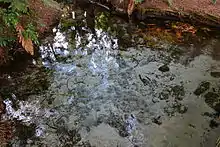Hamurana
Hamurana is a settlement and area of natural springs on the northern side of Lake Rotorua, in Rotorua Lakes within the Bay of Plenty Region of New Zealand's North Island. It includes the deepest natural spring on the North Island, emerging from a rocky area within the Hamurana Springs Recreation Reserve.
Hamurana | |
|---|---|
Rural locality | |
 The Hamurana stream in the Hamurana Springs Recreation Reserve | |

| |
| Coordinates: 38.0308°S 176.2550°E | |
| Country | New Zealand |
| Region | Bay of Plenty |
| Territorial authority | Rotorua Lakes |
| Population (2018) | |
| • Total | 1,032 |
| Postcode(s) | 3097 |
Demographics
| Year | Pop. | ±% p.a. |
|---|---|---|
| 2006 | 963 | — |
| 2013 | 1,005 | +0.61% |
| 2018 | 1,032 | +0.53% |
| Source: [1] | ||
Hamurana had a population of 1,032 at the 2018 New Zealand census, an increase of 27 people (2.7%) since the 2013 census, and an increase of 69 people (7.2%) since the 2006 census. There were 402 households. There were 522 males and 510 females, giving a sex ratio of 1.02 males per female. The median age was 49.4 years (compared with 37.4 years nationally), with 165 people (16.0%) aged under 15 years, 114 (11.0%) aged 15 to 29, 567 (54.9%) aged 30 to 64, and 189 (18.3%) aged 65 or older.
Ethnicities were 91.0% European/Pākehā, 16.9% Māori, 1.2% Pacific peoples, 2.6% Asian, and 2.0% other ethnicities (totals add to more than 100% since people could identify with multiple ethnicities).
The proportion of people born overseas was 19.8%, compared with 27.1% nationally.
Although some people objected to giving their religion, 54.7% had no religion, 32.8% were Christian and 2.6% had other religions.
Of those at least 15 years old, 201 (23.2%) people had a bachelor or higher degree, and 147 (17.0%) people had no formal qualifications. The median income was $39,000, compared with $31,800 nationally. The employment status of those at least 15 was that 480 (55.4%) people were employed full-time, 141 (16.3%) were part-time, and 18 (2.1%) were unemployed.[1]
Hamurana Springs Recreation Reserve
The Hamurana Springs are a collection of springs on the site, officially named Hamurana Springs Recreation Reserve since 1971.[2]
Hangarua Spring
The main spring is 920 feet (280 m) above sea level and is approximately 15 metres (50 ft) deep. It produces an estimated 4 million litres of crystal clear water per hour at a fairly constant temperature of 10 degrees Celsius. The rock surrounding this spring is volcanic (rhyolitic). The spring water travels down from the Mamaku Plateau through underground aquifers, taking 70 years to get here.

Dancing Sands Spring
Another identified spring in the reserve is the Dancing Sands spring, named because of the effect of the emerging water on the sand on the bottom of the spring.

Hamurana Stream
The spring flows as a stream for approximately one kilometre in the Hamurana Springs Recreation Reserve through a patch of redwoods forest before joining Lake Rotorua.[3] In summer the stream is home to rainbow trout who prefer the cooler temperature of the spring water.

Ownership
Ownership of the springs and other nearby sites of cultural significance was returned to the Ngati Rangiwewehi iwi under the Ngati Rangiwewehi Claims Settlement Bill 2014.[4] The Act also declares the Hamurana Springs A and Hamurana Springs B as reserves subject to sections 17 and 18 respectively of the Reserves Act 1977.[5]
The Hamurana Springs Incorporated Society founded in 2003 by members of the Hamurana community, was a group of volunteers who were dedicated to restoring and enhancing the walkway to the springs.
Access for the public to the springs and reserve maintained by the local society was historically free, and continued free public access was rumoured to be a stipulation in the settlement; however, access is now fully enclosed and only paid access is available as of 2019.[6]
References
- "Statistical area 1 dataset for 2018 Census". Statistics New Zealand. March 2020. Hamurana (198000). 2018 Census place summary: Hamurana
- "Place name detail: Hamurana Springs Recreation Reserve". New Zealand Gazetteer. New Zealand Geographic Board. Retrieved 12 March 2020.
- "Hamurana Springs track". New Zealand Department of Conservation. Retrieved 28 March 2009.
- "Ngāti Rangiwewehi Claims Settlement Bill 136-3B (2013), Government Bill Contents". New Zealand Legislation. Retrieved 21 March 2019.
- "Reserves Act 1977 No 66 (as at 21 December 2018), Public Act Contents". New Zealand Legislation. Retrieved 21 March 2019.
- "Hamurana – "Where Nature Comes to Sleep"". Retrieved 21 March 2019.
